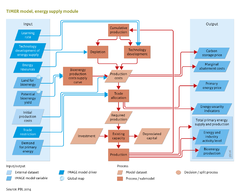Energy supply/Data uncertainties limitations: Difference between revisions
Jump to navigation
Jump to search
No edit summary |
No edit summary |
||
| Line 2: | Line 2: | ||
|Status=On hold | |Status=On hold | ||
|Reference=Mulders et al., 2006; Van Vuuren et al., 2009; Van Vuuren et al., 2010; Hoogwijk, 2004; Hendriks et al., 2004b; IPCC, 2005; | |Reference=Mulders et al., 2006; Van Vuuren et al., 2009; Van Vuuren et al., 2010; Hoogwijk, 2004; Hendriks et al., 2004b; IPCC, 2005; | ||
|Description= | |Description=<h2>Data<\h2> | ||
Below some of the most important data sources used on the supply side of the TIMER model are indicated. The most important data used in the energy supply modules concern information on the size of the different resources at different production costs. | Below some of the most important data sources used on the supply side of the TIMER model are indicated. The most important data used in the energy supply modules concern information on the size of the different resources at different production costs. | ||
*Fossil-fuel resources and costs. Source: [[Mulders et al., 2006]]. Costs from various sources. | *Fossil-fuel resources and costs. Source: [[Mulders et al., 2006]]. Costs from various sources. | ||
| Line 16: | Line 16: | ||
==Limitations== | ==Limitations== | ||
The general limitations of TIMER also apply to the energy supply models, with a few more specific limitations. As a global model, TIMER specifies resource availability in 26 global regions. However, this to some degree ignores the underlying geographical dimensions of individual countries and specific areas. For fossil fuel, this issue leads to heterogeneity within a region (e.g. due to different tax systems), but it is even more important for renewable energy. Here, transport from one area to another can be really important and calculations require the use of other models. Another main limitation concerns the focus on production costs, when describing energy markets. Although long-term developments may be expected to be driven by long-term supply costs, over the last few decades, we have seen that issues related to capacity constraints and market formation over longer periods of time also lead to fossil fuels prices that are very different from production costs. | The general limitations of TIMER also apply to the energy supply models, with a few more specific limitations. As a global model, TIMER specifies resource availability in 26 global regions. However, this to some degree ignores the underlying geographical dimensions of individual countries and specific areas. For fossil fuel, this issue leads to heterogeneity within a region (e.g. due to different tax systems), but it is even more important for renewable energy. Here, transport from one area to another can be really important and calculations require the use of other models. Another main limitation concerns the focus on production costs, when describing energy markets. Although long-term developments may be expected to be driven by long-term supply costs, over the last few decades, we have seen that issues related to capacity constraints and market formation over longer periods of time also lead to fossil fuels prices that are very different from production costs. | ||
}} | }} | ||
Revision as of 17:16, 9 December 2013
Parts of Energy supply/Data uncertainties limitations
| Component is implemented in: |
|
| Related IMAGE components |
| Projects/Applications |
| Key publications |
| References |
